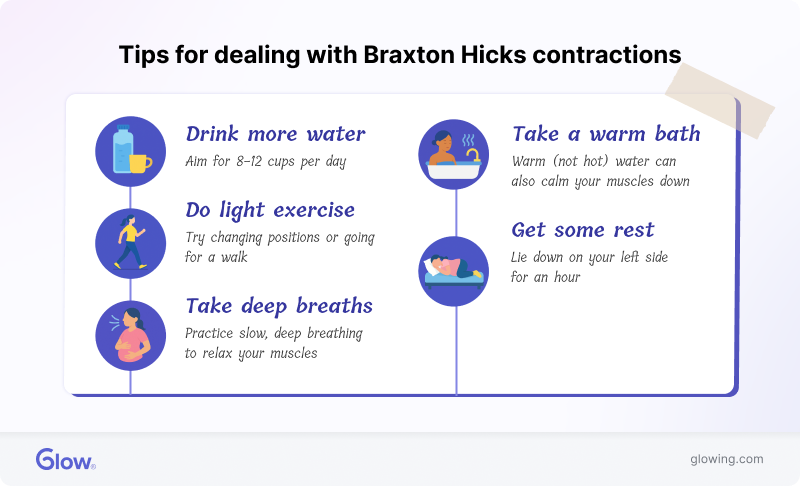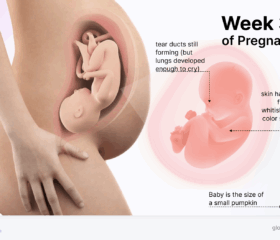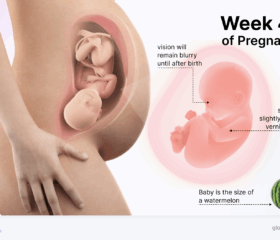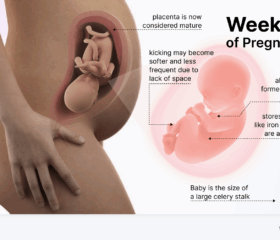Braxton Hicks Contractions vs. True Labor: How to Tell the Difference
The baby’s coming! Or … is she? As you get further into your pregnancy, you’ll experience “false” contractions known as Braxton Hicks contractions. Think of these as your body auditioning for the big show—over and over and over again.

While Braxton Hicks contractions can make you feel like you’re going into labor, especially if this is your first pregnancy and you’ve never felt them before, they’re normal and don’t mean your baby is coming early.
To learn how to tell the difference between Braxton Hicks contractions and true labor (and when your contractions mean you should seek medical attention), keep reading.
What are Braxton Hicks contractions?
The physician John Braxton Hicks was the first to explain what we now know are practice contractions. During these, your body clenches and relaxes the uterus muscles to get them ready for childbirth.
This muscle flexing can be annoying, but it’s part of your body’s rehearsal routine before you actually go into labor.
When do pregnant women usually feel Braxton Hicks contractions?
You may feel Braxton Hicks contractions at any point after the first trimester. 1 Some women experience them as early as week 20, and most notice them in the third trimester, around week 28–30. 2
The good news is that, while some experts believe these contractions help soften and thin the cervix (effacement), they don’t actually cause cervical dilation or result in birth. 3
It is possible to go into labor prematurely, but it’s rare, and experiencing Braxton Hicks contractions doesn’t suggest that it’s going to happen to you.
What causes Braxton Hicks contractions?
The exact cause of Braxton Hicks contractions isn’t known, and there’s no real explanation (yet) for why some women experience more intense or frequent contractions than others.
However, there are common triggers. 4 Dehydration (caused by not drinking enough) can set these spasms off.
So can both physical activity and inactivity. Being still for too long gives your uterus the perfect opportunity to strike, but you can also trigger contractions by exercising, lifting heavy things, or even having sex.
Lastly, your baby may sometimes also set these off by moving around or kicking in the womb.
What do Braxton Hicks contractions actually feel like?
Fortunately, Braxton Hicks contractions are usually mild, but can become more intense as you approach your due date. They often feel like light menstrual cramps.
They may be accompanied by: 5
- A sensation of your baby “balling up”
- Squeezing sensations in your abdomen
- A tightening of your stomach, making it firm to the touch
In your third trimester, you may experience “false labor”—particularly intense contractions that make you feel like the baby’s coming (but she isn’t). Conversely, true labor contractions feel very intense and usually get more painful and regular as you go further into labor.
How to tell the difference between Braxton Hicks and true labor contractions
Again, if you’re never been pregnant before, it can be hard to tell Braxton Hicks contractions from genuine labor contractions. Here are some of the more obvious tells you can look for: 6
| Braxton Hicks | Labor | |
|---|---|---|
| Patterns | - Sporadic / come at irregular intervals - Do not get closer together as time progresses |
- Occur at regular intervals - Get closer together as they go on |
| Location | - Usually stay at the front of the abdomen | - Start in your lower back and move to the front |
| Intensity | - Uncomfortable but not painful - May get stronger or weaker before disappearing |
- Pain may be sharp and intense - Get progressively stronger without easing up |
| Duration | - Last between 30 seconds and 2 minutes | - Start between 30–90 seconds and become longer over time |
| Persistence | - Often taper off after you change position | - Continue regardless of what you’re doing |
Other signs your body may be going into labor
If you’re having trouble telling what types of contractions you have just from their intensity and frequency, watch out for these other signs that you might be experiencing the real thing:
- Your water breaking: Up to 10% of women experience their water breaking before the onset of labor, so it’s not the best idea to wait around for this to happen if you’re wondering whether to seek medical attention. 7 However, if your water does break, it’s a definitive sign that you’re going into labor, not just experiencing especially bad practice contractions.
- Vaginal discharge: Bloody and mucus-like pregnancy discharge (which may be pink, red, or brown) indicates the loss of your mucus plug, which comes before your cervix dilates and you go into labor. 8
- Contractions just five minutes apart: If your contractions are coming five minutes apart or less, this usually kicks off true labor.
These signs may also be accompanied by: 9
- Nausea
- Vomiting
- Diarrhea
- Lower backaches
- Intense pelvic pressure
- Flu-like symptoms, including fever, chills, sore throat, coughing and a runny nose
- Feeling like your baby has “dropped”
- Four or more contractions per hour
If you experience these symptoms along with intense contractions at any point in your pregnancy (not just the last few weeks of the third trimester), get yourself to the doctor. Preterm labor is is not as common, with a rate of around 8%, but it does happen, and the quicker you get medical attention, the better things will be for both you and the baby. 10

Tips for dealing with Braxton Hicks contractions
Unfortunately, there’s no way to avoid Braxton Hicks contractions completely; they won’t stop until you’ve delivered your baby. However, here are a few tips for dealing with your nonconsensual workout session:
- Drink more water: Since these contractions can be triggered by dehydration, one solution is to drink more. You should drink 8 to 12 cups (64 to 96 ounces) daily to avoid dehydration. 11 Warm beverages can also be very soothing when you’re experiencing Braxton Hicks contractions; try sipping on a warm cup of tea or milk, or even plain water.
- Do light exercise: If contractions strike while you’re resting, try changing positions or going for a walk.
- Get some rest: Conversely, if you get them while you’re in the middle of physical activity, try lying down on your left side for an hour.
- Take a warm bath: Having a warm bath or shower can also help relax your muscles.
- Relaxation techniques: Now’s a good time to practice those breathing techniques you’ll need when your baby finally decides to make an appearance. One common technique is to inhale deeply through your nose and exhale through your mouth, remembering to breathe from your abdomen and not your chest. 12
When to call your doctor about your contractions
While Braxton Hicks contractions are normal, you should call your doctor or midwife if you notice certain signs:
- Severe pain: If you experience sudden or severe pain, it could be a sign of complications like placental abruption or preterm labor. 13
- Decreased baby movement: If you notice your baby being more sluggish than usual, it might be a sign that she’s not well. 14
- Signs of labor: Just to reiterate, if you notice any of the signs of labor we listed above, it’s time to get to the hospital.
It’s always better to be safe than sorry, so don’t hesitate to get in touch with your doctor, even if there’s a chance it’s just a false alarm. Remember, you are your own best advocate.
Is it normal to have no Braxton Hicks contractions?
It’s normal to not feel any Braxton Hicks contractions. While they feature in all pregnancies, some women’s contractions are mild enough that they don’t notice them at all. Note that there’s no definitive research yet linking these practice contractions to the actual labor difficulties (or lack thereof) you might face during childbirth.
Final thoughts
Pregnancy can be an emotional rollercoaster—anxiety, excitement, even more anxiety. Remember that every woman’s experience is unique, and that most of the time, Braxton Hicks contractions don’t indicate that anything’s wrong.
Despite how nerve-wracking these muscle spasms can be, you’ll be holding your beautiful baby in your arms soon enough, and all of these practice pains will be worth it.
Article Sources
- MedlinePlus. "Am I in labor?" Retrieved April 15, 2025.
- PeaceHealth. "Contractions During Pregnancy: What to Expect" Retrieved April 15, 2025.
- StatPearls. "Braxton Hicks Contractions" Retrieved April 15, 2025.
- Penn Medicine Lancaster General Health. "What Are Braxton Hicks Contractions?" Retrieved April 15, 2025.
- North Carolina Department of Health and Human Services. "Your Pregnancy Guide" Retrieved April 15, 2025.
- The University of Texas Southwestern Medical Center. "False alarm: Braxton Hicks contractions vs. true labor" Retrieved April 15, 2025.
- Cleveland Clinic. "Premature Rupture of Membranes" Retrieved April 15, 2025.
- Cleveland Clinic. "Mucus Plug" Retrieved April 15, 2025.
- U.S. Department of Veterans Affairs / Department of Defense. "2023 Pregnancy Purplebook" Retrieved April 15, 2025.
- National Health Service. "Premature labour and birth" Retrieved April 15, 2025.
- American College of Obstetricians and Gynecologists. "How much water should I drink during pregnancy?" Retrieved April 15, 2025.
- Corewell Health. "Breathing Exercises & Visualization" Retrieved April 15, 2025.
- MedlinePlus. "Aches and pains during pregnancy" Retrieved April 15, 2025.
- Tommy’s. "Baby movements in pregnancy" Retrieved April 15, 2025.







